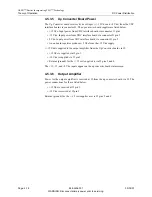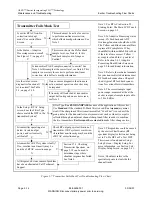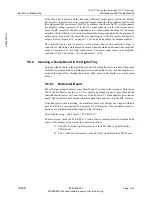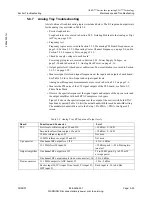
APEX
™
Exciter Incorporating FLO
™
Technology
Maintenance and Troubleshooting
Default Settings For DIagnostics Screens
Page: 5-10
888-2604-001
03/08/07
WARNING: Disconnect primary power prior to servicing.
5.3
Default Settings For DIagnostics Screens
The diagnostics functions are useful for testing and troubleshooting the exciter, but if left
in the wrong position, the transmitter or exciter will not function properly. Table 5-1 is a
quick reference for the default diagnostics settings.
Table 5-1 Diagnostics Screens Default Settings
Status Screen With
Diagnostics
Text Location Within
Manual
Variable
Default Setting
Adaptive Processing
See Section 3.4.3.1, Adaptive
Processing Diagnostics, on
page 3-11
Loopback (choices None, Analog,
or Digital)
None
Test Tones
Disabled
RF & IF Processing
(Screen 3 of 4)
Section 3.4.5.3.1, Up
Converter Diagnostics, on
page 3-22
Output Power AGC
Enabled
Tune A (UHF up converter tunable
notch filter)
Values depend on
UHF channel,
see Note 1
Tune B (UHF up converter tunable
B. P. filter)
RF & IF Processing
(Screen 4 of 4)
Section 3.4.5.4.1, Down
Converter Diagnostics, on
page 3-24
RF Sample Select (at down
converter input)
Automatic
RF Sample AGC (sets down
converter output level)
Enabled
System Control
(Screen 1 of 5)
Section 3.4.6.1.1, Controller
Board Diagnostics, on
page 3-26
Bit Fifo Test Pattern, used by
engineering. If enabled, will block
normal signal flow.
Disabled
System Control
(Screen 2 of 5)
Section 3.4.6.2.1, External I/O
Diagnostics, on page 3-28
Analog Loopback
Disabled
Analog Output A
0
Analog output B
0
System Control
(Screen 3 of 5)
Section 3.4.6.3.1, CAN
Diagnostics, on page 3-30
A CAN Test Message is available
Disabled
Note 1. Tune A and/or Tune B may have been changed from the default value to improve the uncorrected output of
the exciter. Record the existing Tune A and B values before changing them. The default values of Tune A
and B can be restored by pressing the Reset Tuning soft key on the Up Converter Diagnostics screen.
















































